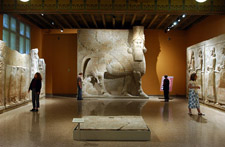 |
|
|||||||||
Standing Guard The Oriental Institute Museum’s Mesopotamian Gallery reopens its irreplaceable collection. Back in April 1996, when the Oriental Institute (OI) Museum closed its doors for repairs and renovations, the sense of urgency was palpable. The enemies at the gate were Chicago’s seasonal variations in temperature and relative humidity, variations that threatened the 100,000-plus artifacts gathered since 1903 on University-led expeditions to every country in the Near East. Of all those objects, the best-known was also the most spectacular: the human-headed winged “bull.” The 40-ton, 16-foot-tall stone sculpture represents a lamassu, or guardian figure. It was discovered by Oriental Institute archaeologists in 1929. Three years later—after an arduous journey down the Tigris River and across the Atlantic, followed by a circuitous, tunnel-avoiding railway trip from New York to Chicago—it was installed in the nearly completed Oriental Institute building. When the OI’s Edgar and Deborah Jannotta Mesopotamian Gallery made its debut this October, the Assyrian bull was in its accustomed place along the east wall, calmly watching over the gallery’s treasures. Now, however, as part of a new installation, the Yelda Khorsabad Court, the bull is flanked by six ten-foot-tall stone reliefs that originally stood beside it on the throne room facade in the palace of Sargon II. The third and largest of the museum’s five galleries to reopen—at 5,428 square feet, it has 2,626 artifacts on display—the Mesopotamian Gallery houses an assembly of artifacts from ancient Iraq that underscore the region’s contributions to modern life. “The Mesopotamians were true innovators,” notes Museum director Karen Wilson, who oversaw the gallery’s reinstallation, “and our heritage from them includes many of the things we now take for granted,” including writing, mathematics, time, urban civilization, the wheel, the sail, and astronomy. The objects’ value is heightened by the fact that many are similar to items feared lost or destroyed when Baghdad’s Iraqi National Museum was left unprotected this past April after Saddam Hussein’s fall. In fact, many of the pieces in the museum were excavated by Chicago teams in the first half of the 20th century, when Iraq allowed foreign archaeologists to take home finds if more than one of a kind had been unearthed. As a result, as OI director Gil Stein told the Chicago Tribune, the collection is “very rare. You couldn’t duplicate it or do it today.” Adding to the collection’s distinctiveness is its aim: to provide a comprehensive view of an ancient culture. “Because Oriental Institute archaeologists recovered these artifacts with painstaking care, we know not only the sites from which they derive,” says Stein, “but also the buildings, the room, the stratigraphic layer, and—most important of all—the other artifacts found in association. The archaeological context of discovery is the priceless knowledge that allows us to derive an understanding of a once flourishing culture from an inert artifact.” To that end the Jannotta Gallery takes a chronological approach. The Robert and Linda Braidwood Prehistory Exhibit, for example, goes back 150,000 years to follow the shift from nomadic groups to settled farming villages. Other installations focus on writing and the written tradition, the use of commercial seals, household and family, and the roles of the palace and the temple in organizing ancient urban life.—M.R.Y.
|
|
Contact
|

